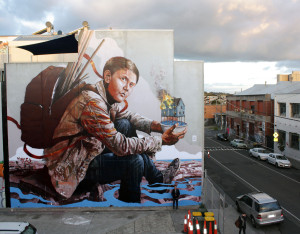Street art explores cultural identity

‘The refugee’ mural by Sydney street artist Fintan Magee.
Melbourne is certainly no stranger to street art, but its latest big edition is more thought-provoking than most.
Fintan Magee, or ‘Australia’s Banksy’, has treated the city to an enormous mural titled ‘The Refugee’.
The Sydney street artist spent the first few days of April on a cherry picker painting the side of a three story building in Collingwood’s Easey St.
The mural shows a young man holding a burning Queenslander house, one of Australia’s most distinctive architectural designs.
The young man, who wears a backpack with sticks poking out, looks as though he could come from various cultural backgrounds. He seems to be moving through a surrealist world made of rocks, rivers and grey skies.
“For this piece I wanted to tell the story of a climate refugee in the future, his back pack is full of materials for rebuilding, he carries his memory of his lost home, his world is flooded,” said Fintan.
The world-renowned artist often deals with issues of climate change and cultural identity in his colourful and distinctly dystopian work.
“Growing up in Brisbane there was always a lack of cultural identity outside of football, conservatism and boganism. I guess my work was a way for me to explore my own voice and understand others.”
“Immigration is a pretty big issue in Australia and we are really not dealing with the refugee situation in the right way right now, so I like to explore that in my work when I can.”
Fintan began writing graffiti at age 13 but crossed over to contemporary muralism and street art in 2010.
Since then he has been travelling the globe creating huge pieces of art, filled with complex ideas and hidden narratives.
In his art Magee hopes to stimulate conversation through how the audience views his work.
“Working on the street I am in the position to reach an audience that would not always be exposed to art. I think in this sense it can play an important role and create a bridge between galleries and the public.”
Ruby Brown
AMES Staff Writer












